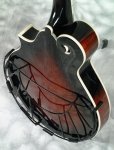Zetajazz44
New member
mshilarious said:I haven't tried it, but it makes sense to me. In that respect the front and back of a bass is analogous to a snare drum.
Yep, that's it... Instruments of the violin family have a sound post that not only hold the top up under string tension, but it also 'connects' the top with the back... When violin makers make the tops and backs, they 'tune' them to 2 different notes... I believe the top is D, and the back is E... (Maybe the other way around...) At any rate, yes, the back resonates too. These combined give a 'full' sound when the strings are bowed.
If you've ever noticed violin players using a shoulder rest... This helps wedge the violin between their shoulder and chin...but it also supports the back at it's edges and doesn't allow the shoulder of the player to 'mute' the vibrations of the back... You can play a violin with and without a shoulder rest and there is a definate difference in it's sound...
A few years back a guy invented a "wire frame" device for mandolins to help hold the back of the instrument off the players belly... This device is marketed as: "ToneGard". I think it was originally invented to keep from scratching the back on buttons..etc, but it does enhance the sound... Even though a mandolin doesn't have a soundpost, it still enhanced it's sound... I'm attaching a picture of one of these devices, ToneGard...
BTW, I also mic both sides of my fiddle when I'm recording... I use 2 ribbon mics, one on the top and one on the bottom... It definately make a difference...


